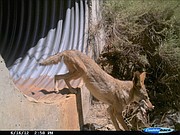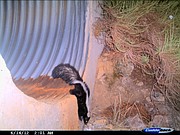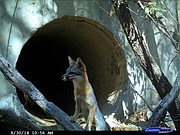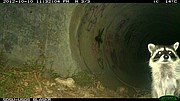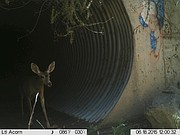-
As dangerous as Highway 67 is for drivers, it is even trickier for the wildlife that live in the rich habitat on either side, so when Caltrans looked at placing barriers down the middle for vehicle safety, the agency started talking with Dr. Megan Jennings, a conservation ecologist and post-doctoral researcher who has worked on projects with UCSD and SDSU.
COURTESY OF MEGAN JENNINGS
Coyote with lunch
COURTESY OF MEGAN JENNINGS
Skunk
COURTESY OF MEGAN JENNINGS
Gray fox
COURTESY OF MEGAN JENNINGS
Raccoon
COURTESY OF MEGAN JENNINGS
Mule deer
COURTESY OF MEGAN JENNINGS
Bobcat
“It falls right in the middle now where the animals have to cross [the road] to utilize both sides of open space in the multispecies protection plan,” she says. Jennings studied the area between Mapleview Street in Lakeside and Dye Road in Ramona — identifying the most common wildlife crossings by tracking and studying roadkill. Then she set up infrared cameras at the most common crossings.
“There’s been at least one mountain lion, ringtail — which is a cat-looking mammal that’s actually related to raccoons, coyote, deer, bobcat, and gray fox, and all the animals you’d expect: raccoons, possum, skunks,” she said.
Based on a preliminary study, she found three or four areas that will be problematic: on the grade coming up to Fosters Truck Trail south of Scripps Parkway, the area around Iron Mountain, the Mt. Woodson area, and the area leading into Ramona where the road narrows to two lanes but people drive fast. It isn’t just about protecting the individual critters.
“It’s about preserving gene flow and stable populations of these animals,” she said. “And the highway is already dangerous for drivers, but when you add on top trying to avoid an animal — your natural instinct is to try to avoid them.”
Jennings’s studies led her to culverts under the highway — drainage pipes of corrugated steel or concrete box-shaped tunnels. Many were blocked by growth or fences, but wildlife seemed to be okay with going under the road.
Corrugated steel culvert| Corrugated steel culvert manufacturer| corrugated steel pipe
Coupon Code: “freeshipping” on any order 8000 from corrugatedsteelculvert.com
“The types of crossings a deer would use are different than what a mountain lion prefers — mountain lions like things that are a little more open, while deer are prey and they don’t like to be out in the open — they prefer places they can blend in and where they can see the end of the tunnel from the beginning.
Examining roadkill — usually reduced to picked-clean bones — taught Jennings about an odd place where time, nature, and rush hour collide.
“The highest rates of roadkill coincide with times of early nightfall, when rush hour lines up with dusk. That time of year, deer are in rut [mating season], coyotes are looking for a partner, and the predators that come out at night meet up with a lot of drivers in a hurry to get home,” Jennings said.
The solutions Jennings and Caltrans are contemplating include clearing the culverts and making the approaches to them more straightforward. The idea is to lead the animals to where it’s safe for them to cross.
“Make it bigger, wider so animals can see the end of the tunnel is one idea,” she said. “Better lighting and clearing the culverts for better animal visualization would help a lot.”
And there’s a special idea in play — an animal bridge over the highway at Mt. Woodson. It’s just an idea at this point, but it has worked in other places, including Los Angeles, with its mountain lion bridge.
“Because of the steep hills on either side, it might be the best idea to keep the animals off the road entirely — it would take a lot of study to do it right so it worked for the animals,” Jennings said.
 votre commentaire
votre commentaire
-
The machine is perfect to carry out an automated inspection to help maintain the product quality and could be more beneficial for the manufacturing industry.
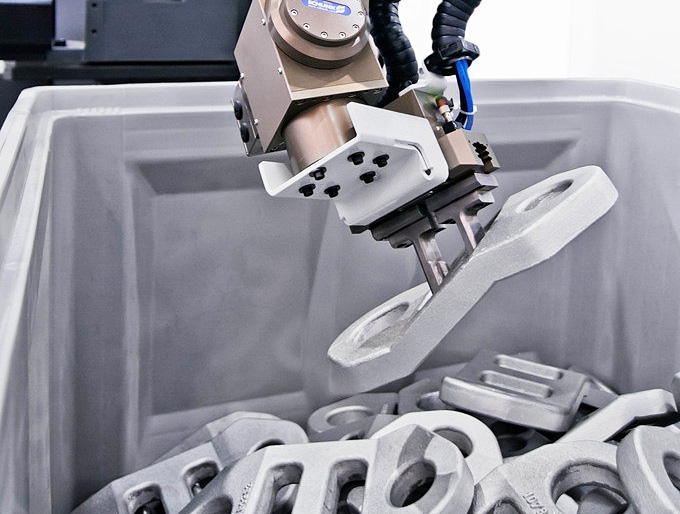
For manufacturing products in an error-free manner, there are visual inspections that must be carried out in different manufacturing stages. Sipotek Technology designs and develops CCD visual inspection machines for carrying out visual inspections in an efficient and flawless manner. The company has a team of R&D professionals and industrial automation engineers who keep innovating to develop a better line of visual inspection machines for the manufacturing industry. These machines help clients meet the global demand of quality products.
According to the spokesperson of Sipotek Technology, the visual inspection is one of the principal technological areas that most manufacturing companies focus on today. The Sipotek Visual Inspection Machine is ideal for testing of parts made of aluminum, plastic, rubber, stainless steel and other materials. With outstanding detection accuracy, the machine is the right fit for the inspection of length, height, diameter, deformation and distortion. It can also check the dark spot, blur, scratch etc on the surface of the product. Designed with the automatic feeding system, the machine can perform its task at an excellent speed.
The spokesperson reveals that they have a team of professionals who are experts in the software design and the image comparison technology to develop cutting edge visual inspection machines. The company’s automated optical inspection machine can prove conducive to automate the manufacturing process by eliminating the human errors. The machine is efficient enough to test a wide range of parts, and can include features, like data collection, storage of data or image, good or bad total part counters etc. The spokesperson states that the machine not only inspects the product, but also processes it. The image captured by the machine can be processed to carry out several tasks, including product identification, measurement of dimension, inspection of the surface finish, character recognition, barcode reading and so on.
In order to stay competitive, it is essential to automate the manufacturing process, and for which the automated visual inspection plays a pivotal role. Manufacturing companies that still rely on the manual inspection process can now check the visual inspection machines that Sipotek Technology has in its portfolio. They have different types of machines, such as one-click detection machine, cloud disk high speed inspection machine, CCD visual inspection machine, full-size precision testing machine, high speed precision testing machine, pallet and carrier belt mutual transfer automatic inspection machine and other types of machines. Besides the primary task of measuring inspection, these machines can perform several types of tasks, such as color matching and verification, pattern recognition, pre-processing inspection, surface inspection and so on.
Vision Inspection Machine | Machine Vision Inspection System | Automated Optical Inspection Machine
Free shipping coupon code: "freeshipping" on any order from sipotek.net
One can check the specifications and features of these visual inspection machines by visiting the website https://www.sipotek.net/ .
About Shenzhen Sipotek Technology Co., Ltd
Started in 2002, Sipotek Technology is located in Shenzhen in China. The company designs and manufactures visual inspection systems with its avant-garde R&D department and a great experience in artificial vision technologies. The Sipotek Technology staff supports customers 360 degrees, from listening to their requests to the development of ambitious machines for quality control.

For Inquiries:
Contact Person: James Yuan
Company: Shenzhen Sipotek Technology Co., Ltd
Tel: 86-755-36994123
Email: info@sipotek.net
Website: https://www.sipotek.net/automated-inspection-machine/
 votre commentaire
votre commentaire
